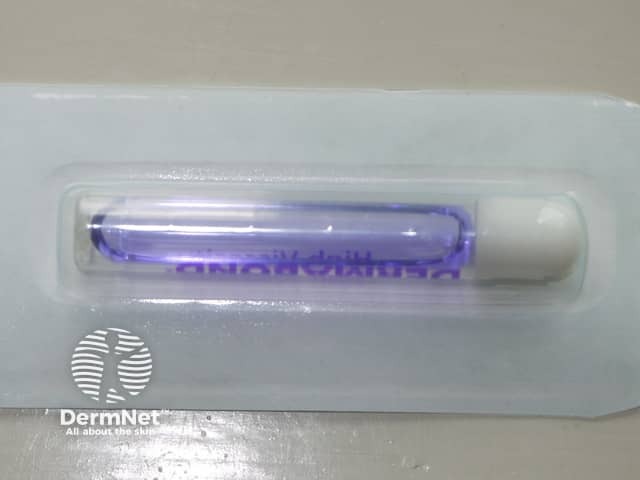Main menu
Common skin conditions

NEWS
Join DermNet PRO
Read more
Quick links
Author: Alicia May Li Loh, Medical Student, University of Auckland, New Zealand, 2010.
Introduction
How to use
Benefits
Disadvantages
Side effects
Treatment
The topical skin adhesives (or glues) are liquid cyanoacrylate monomers that polymerize into long solid chains upon contact with blood or a wound surface, thus holding wound edges together.1
The table below lists the types of topical skin adhesives along with their trade name.
Type |
Trade name |
|---|---|
2-Octyl-cyanoacrylate |
Dermabond® |
n-2-Butyl-cyanoacrylate |
Histoacryl® |
2-Ethyl-cyanoacrylate |
Epiglu® |

Topical skin adhesives
Topical skin adhesives are ideal for simple cuts such as punctures from minimally invasive surgery (e.g. hair transplantation), skin graft sites, and simple trauma-induced lacerations.
Topical skin adhesives are ideal for:
However, topical skin adhesives cannot be used on all cuts. They are generally not used on:
Benefits of topical skin adhesives include:
Disadvantages compared to suturing include:
At the time of treatment some patients may report a sensation of heat or minor discomfort.
After treatment the area may be red, swollen, painful or tender. See your doctor if these signs persist for a few weeks.
Besides that, topical skin adhesives can also cause wound dehiscence (reopening of a previously closed wound). Topical adhesive may be reapplied or sutures can be used.
In rare cases, contact allergic dermatitis may occur during or after the treatment. Reactions usually clear up in a few days but occasionally persist for months. See your doctor immediately if you have an allergic reaction.
Allergic reactions may include:
The safety of topical skin adhesives on animals has not been established.